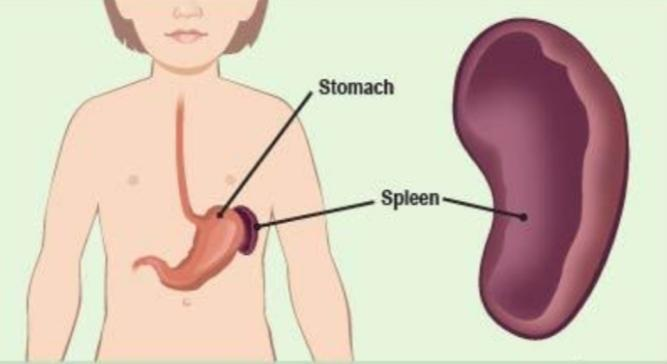
What is the function of the spleen in the body?
Answer
393.6k+ views
Hint: The spleen is a lymphoid organ that is situated in the left part of the abdomen. It is a purple colored organ that varies in size and shape among people. Usually, it is fish shaped and 4 inches long. The rig cage protects the spleen. It is present in all vertebrates.
Complete answer:
The spleen is a part of the lymphatic system that is located under the diaphragm. The lymphatic system helps in the removal of some substances, activating the white blood cells and generating an immune response. The spleen plays various important roles in the human body. It is primarily related to red blood cells and the lymphoid system. The functions of spleen are-
As a lymphoid organ, it is primarily involved in the filtration of blood and generates immune response. When foreign particles or pathogens enter the body, it activates the white blood cells to fight off with these pathogens. Thus, the spleen protects the body from a number of disease causing pathogens by detecting them.
The old and damaged red blood cells (RBCs) are destroyed in the spleen. For this reason, it is also called the graveyard of RBCs.
It also provides protection against some bacteria that cause pneumonia and meningitis.
It is involved in recycling of iron and acts as a blood reserve during hemorrhagic shock. The spleen stores RBCs, WBCs (white blood cells) and platelets.
In a foetus, it helps in the formation of all types of blood cells.

Note:
The spleen also has a clinical significance. It helps in the detection of certain diseases. For example- splenomegaly. Splenomegaly is a condition in which the spleen becomes enlarged. In children, viral infection is the most common cause of splenomegaly. In adults, it can be caused due to several diseases such as viral mononucleosis, leukemia, lymphoma etc.
Complete answer:
The spleen is a part of the lymphatic system that is located under the diaphragm. The lymphatic system helps in the removal of some substances, activating the white blood cells and generating an immune response. The spleen plays various important roles in the human body. It is primarily related to red blood cells and the lymphoid system. The functions of spleen are-
As a lymphoid organ, it is primarily involved in the filtration of blood and generates immune response. When foreign particles or pathogens enter the body, it activates the white blood cells to fight off with these pathogens. Thus, the spleen protects the body from a number of disease causing pathogens by detecting them.
The old and damaged red blood cells (RBCs) are destroyed in the spleen. For this reason, it is also called the graveyard of RBCs.
It also provides protection against some bacteria that cause pneumonia and meningitis.
It is involved in recycling of iron and acts as a blood reserve during hemorrhagic shock. The spleen stores RBCs, WBCs (white blood cells) and platelets.
In a foetus, it helps in the formation of all types of blood cells.

Note:
The spleen also has a clinical significance. It helps in the detection of certain diseases. For example- splenomegaly. Splenomegaly is a condition in which the spleen becomes enlarged. In children, viral infection is the most common cause of splenomegaly. In adults, it can be caused due to several diseases such as viral mononucleosis, leukemia, lymphoma etc.
Recently Updated Pages
Master Class 11 Accountancy: Engaging Questions & Answers for Success

Express the following as a fraction and simplify a class 7 maths CBSE

The length and width of a rectangle are in ratio of class 7 maths CBSE

The ratio of the income to the expenditure of a family class 7 maths CBSE

How do you write 025 million in scientific notatio class 7 maths CBSE

How do you convert 295 meters per second to kilometers class 7 maths CBSE

Trending doubts
Which are the Top 10 Largest Countries of the World?

What is a transformer Explain the principle construction class 12 physics CBSE

Differentiate between homogeneous and heterogeneous class 12 chemistry CBSE

Draw a labelled sketch of the human eye class 12 physics CBSE

What are the major means of transport Explain each class 12 social science CBSE

What is the Full Form of PVC, PET, HDPE, LDPE, PP and PS ?




